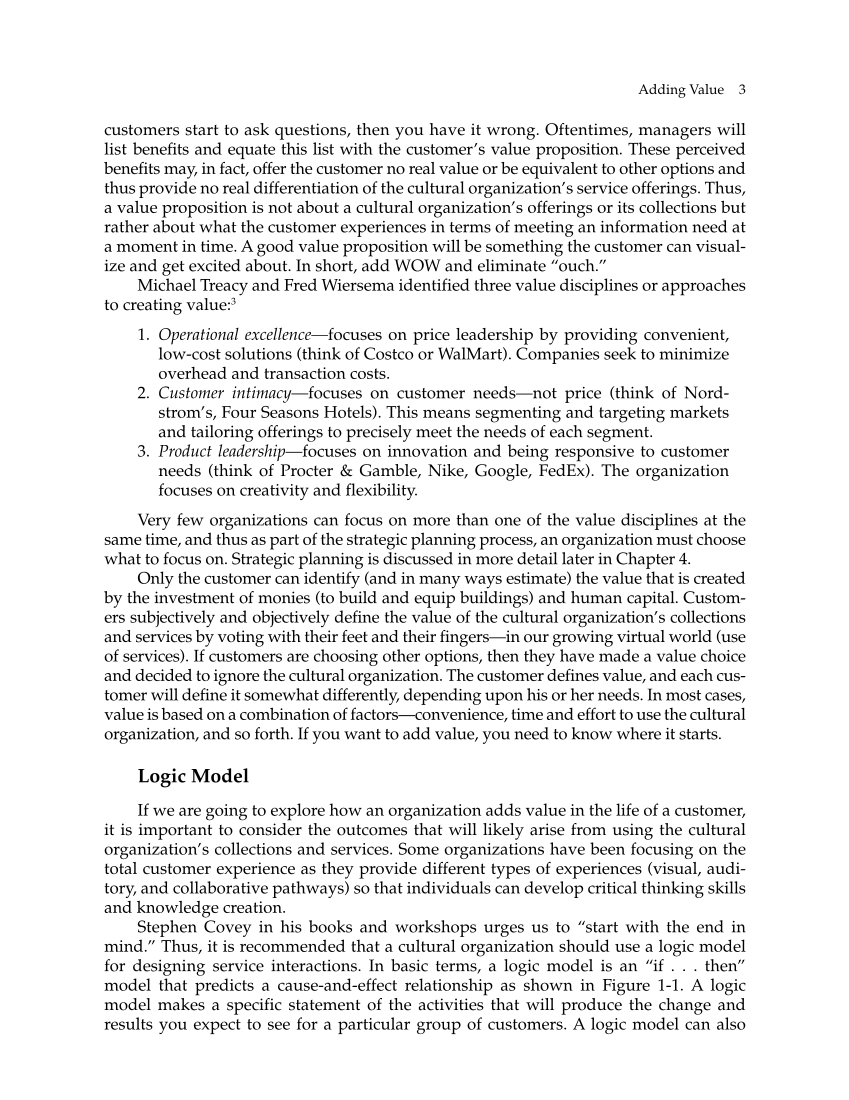Adding Value 3 customers start to ask questions, then you have it wrong. Oftentimes, managers will list benefits and equate this list with the customer’s value proposition. These perceived benefits may, in fact, offer the customer no real value or be equivalent to other options and thus provide no real differentiation of the cultural organization’s service offerings. Thus, a value proposition is not about a cultural organization’s offerings or its collections but rather about what the customer experiences in terms of meeting an information need at a moment in time. A good value proposition will be something the customer can visual- ize and get excited about. In short, add WOW and eliminate “ouch.” Michael Treacy and Fred Wiersema identified three value disciplines or approaches to creating value: 3 1. Operational excellence— focuses on price leadership by providing convenient, low-cost solutions (think of Costco or WalMart). Companies seek to minimize overhead and transaction costs. 2. Customer intimacy— focuses on customer needs—not price (think of Nord- strom’s, Four Seasons Hotels). This means segmenting and targeting markets and tailoring offerings to precisely meet the needs of each segment. 3. Product leadership— focuses on innovation and being responsive to customer needs (think of Procter & Gamble, Nike, Google, FedEx). The organization focuses on creativity and flexibility. Very few organizations can focus on more than one of the value disciplines at the same time, and thus as part of the strategic planning process, an organization must choose what to focus on. Strategic planning is discussed in more detail later in Chapter 4. Only the customer can identify (and in many ways estimate) the value that is created by the investment of monies (to build and equip buildings) and human capital. Custom- ers subjectively and objectively define the value of the cultural organization’s collections and services by voting with their feet and their fingers—in our growing virtual world (use of services). If customers are choosing other options, then they have made a value choice and decided to ignore the cultural organization. The customer defines value, and each cus- tomer will define it somewhat differently, depending upon his or her needs. In most cases, value is based on a combination of factors—convenience, time and effort to use the cultural organization, and so forth. If you want to add value, you need to know where it starts. Logic Model If we are going to explore how an organization adds value in the life of a customer, it is important to consider the outcomes that will likely arise from using the cultural organization’s collections and services. Some organizations have been focusing on the total customer experience as they provide different types of experiences (visual, audi- tory, and collaborative pathways) so that individuals can develop critical thinking skills and knowledge creation. Stephen Covey in his books and workshops urges us to “start with the end in mind.” Thus, it is recommended that a cultural organization should use a logic model for designing service interactions. In basic terms, a logic model is an “if . . . then” model that predicts a cause-and-effect relationship as shown in Figure 1-1. A logic model makes a specific statement of the activities that will produce the change and results you expect to see for a particular group of customers. A logic model can also
Document Details My Account Print multiple pages
Print
You have printed 0 times in the last 24 hours.
Your print count will reset on at .
You may print 0 more time(s) before then.
You may print a maximum of 0 pages at a time.


















































































































































































































































































































